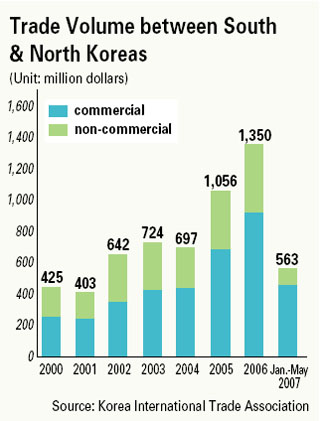South Korean Ministry of Unification
Exchange of People
Visits to North Korea
During the month of April, the total number of accomplishments for visits to North Korea was 3,281, an increase of 99% from 1,648 in the previous month. It included 3,136 for economic exchanges, 60 for social and cultural exchanges, 81 for humanitarian aid and 4 for family reunion.
The number increased by 222% from 1,019 in April 2006.
The total number of actual visits made during this period was 13,250 an increase of 40% from 9,894 in the previous month. It included 9,886 for economic exchanges, 1,411 for social and cultural exchanges, 1,807 for humanitarian aid and 146 for family reunion.
The number increased by 39.5% from 9,495 during the same period last year.
The total number of Mt. Geumgang tourists during April was 17,805 in 30 trips altogether, an increase of 1.1% from 17,610 in previous month and a 35% decrease from 27,404 during the same period last year.
Contacts with North Koreans
During the month of April, the total number of the accomplishments for inter-Korean contacts was 72, a decrease of 17.2% from 87 in the previous month. It included 46 for economic exchanges, 23 for social and cultural exchanges, 1 for humanitarian aid and 2 for family reunion.
The number increased by 111.8% from 34 during the same period last year.
The total number of actual contacts made during this period was 229, an increase of 1.3% from 226 in the previous month, It included 69 for economic exchanges, 151 for social and cultural exchanges, 2 for humanitarian aid and 7 for family reunion.
The number increased by 218% from 72 during the same period last year.
In April, a total of 178 North Koreans visited to South Korea, including 72 for participating in ITF(International Taekwondo Federation) founding ceremony of Seoul chapter, 72 for Inter- Korean Worker’s Unification Convention on May Day, 32 flight attendants of Koryeo Air.
Inter-Korean Trade
The total volume of inter-Korean trade during April 2007 was $132,869 thousand, showing an 98.5% increase from $66,952 thousand during the same month last year(a 28.8% increase from $103,151 thousand during the previous month).
Trade Type
The total amount of Commercial Transaction were $86,052 thousand (64.8%), showing an 52.9% increase from $56,275 thousand(84.1%) during the same month last year.
The total amount of Non-Commercial Transaction were $46,817 thousand(35.2%), showing an 338.5% increase from $10,677 thousand(15.9%) during the same month last year.
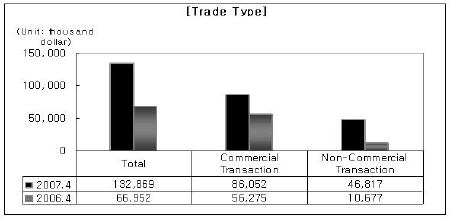
Import & Export Status
Import from North Korea totalled $46,028 thousand, an 51.5% increase from $30,388 thousand during the same month last year(a 21.5% decrease from $58,637 thousand during the previous month).
- Composition by Items (Unit : %)
Agricultural and aquatic products 21
Minerals 19.6
Textile products 28.5
Steel and metal products 18.1
Livlihood supp 4.5
Export to North Korea totalled $86,841 thousand, an 137.5% increase from $36,564 thousand during the same month last year(a 95.1% increase from $44,514 thousand during the previous month).Composition by Items (Unit : %)
Agricultural and aquatic products 48.7
Textile products 8.8
Steel and metal products 7.9
Machineries 16
Electric and products 7.5
The total volume of General Trade during April 2007 was $26,850 thousand ,a 61.9% increase from $16,589 thousand during the same month last year(a 23.9% decrease from $35,265 thousand in the previous month).The volume of import in General Trade was $25,450 thousand, export was $1,400 thousand and had 94.8%, 5.2% each other.
The composition rate by items had a great part of Minerals(33.8%), Agricultural and Aquatic Products(33.1%), Steel and Metal products(29.3%), Electric and Electronic Products(1.5%)
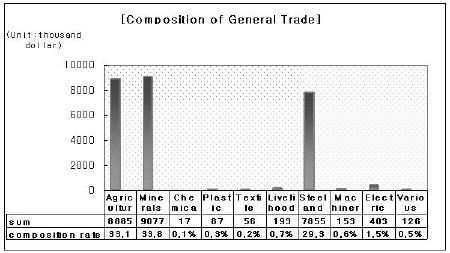
The total volume of Processing-on-Commission Trade during April 2007 was $19,992 thousand, a 38.8% increase from $14,402 thousand during the same month last year.(a 15.4% decrease from $23,629 thousand in the previous month)
The volume of import in Processing-on-Commission Trade was $14,063 thousand, export was $5,929 thousand and had 70.3%, 29.7% each other.
The composition rate by items had a great part of Textiles(79.6%), Electric and Electronic Products(8.8%), Agricultural and Aquatic Products(8.7%)
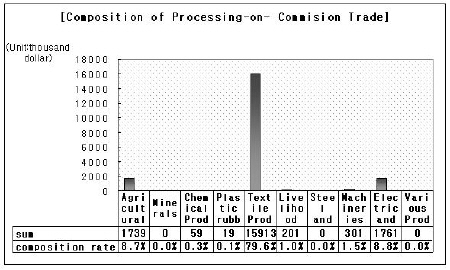
The total volume of Economic Cooperation Project during April 2007 was $39,210 thousand, a 55.1% increase from $25,284 thousand during the same month last year(a 12.4% increase from $34,881 thousand in the previous month).
The volume of import in Economic Cooperation Project was $6,513 thousand, export was $32,697 thousand and had 16.6%, 83.4% each other.
The composition rate by items had a great part of Machineries(29.0%), Steel and Metal Products(16.2%), Electric and Electronic Products(14.5%), Livelihood supplies(9.2%)
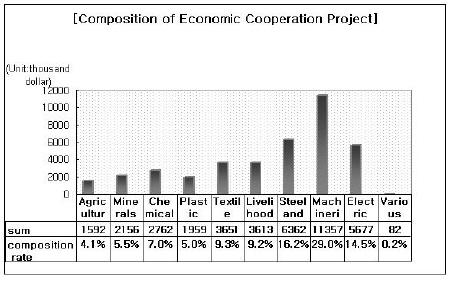
The total volume of Aid to N.K. during April 2007 was $46,815 thousand, a 338.5% increase from $10,677 thousand during the same month last year(a 399.5% increase from $9,373 thousand in the previous month).
The volume of export was $46,815 thousand.
The composition rate by items had a great part of Chemical Products(84.7%), Machineries(8.3%), Plastic rubber and Leather(2.3%), Agricultural and Aquatic Products(1.2%).
Humanitarian Projects
A. Separated Families
Exchange: # of casses(#of people)
Application for contact 9(14)
Address check 2(7)
Reunion 6(25)
Exchange of letters 36


